
The Rue Victor-Hugo is a pedestrian street in the 2nd arrondissement of Lyon, in the Ainay district of the Presqu'île quarter, reputed to be one of the most known shopping area of Lyon. From north to south, it connects the Place Bellecour to the Place Carnot. Beyond the Place Bellecour, the Rue de la République is its natural extension, thus creating one of the biggest pedestrian streets in Europe. The street is served by metro stations Perrache, Bellecour and Ampère - Victor Hugo. It belongs to the zone classified as World Heritage Site by UNESCO.
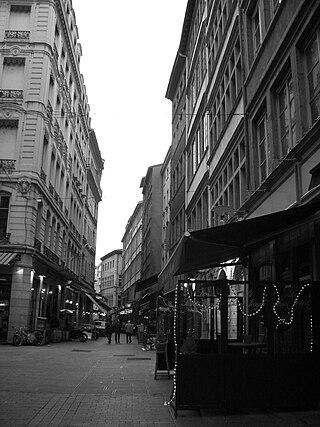
The Rue Mercière is a street of Les Cordeliers quarter in the 2nd arrondissement of Lyon. From north to south, it connects the Place des Jacobins to the Place d'Albon. This street is served by metro stations Bellecour and Cordeliers of the line and by the bus station Jacobins of the lines 91 and 99. It belongs to the zone classified as World Heritage Site by UNESCO.

The Rue des Marronniers is a street located in the Bellecour quarter, in the 2nd arrondissement of Lyon. It is a small paved pedestrian street famous for its many bouchons. It is served by the metro station Bellecour and many buses. The street belongs to a zone classified as a World Heritage Site by UNESCO.

The Cours Charlemagne is a large central street located in the Perrache quarter, in the 2nd arrondissement of Lyon. This street is dedicated to Charlemagne, who came several times to Lyon. In addition, the bishop Leidrade represented the emperor in the city and by his great work of reconstruction. The Cours Charlemagne begins at the Place des Archives, just at the south of the vaults of the interchange of Perrache. It ends on the Quai Perrache, which overlooks the Pont Pasteur.
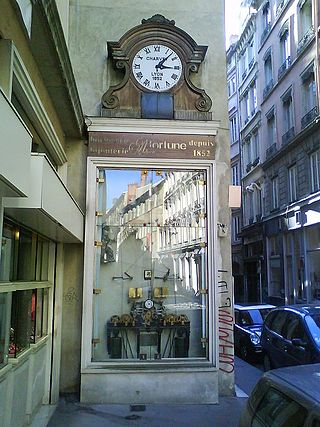
The Rue de la Poulaillerie is a street located in the 2nd arrondissement of Lyon, France. It was first named rue Vaudran, and also rue Maudite in reference to Peter Waldo, who founded what was considered a heresy at the time, the street received its current name from the fact that people exchanged poultry until 1835, when part of this trade emigrated to the covered market of La Martinière.
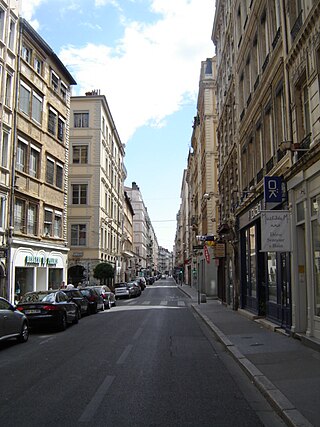
The Rue de Brest is a street located in the 2nd arrondissement of Lyon. It is one of the main shopping and tourist streets of the city center, parallel to the Rue Édouard-Herriot. It begins in the wake of the Rue Paul Chenavard and ends with the Place des Jacobins.
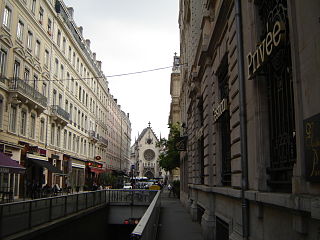
The Rue de la Bourse is a street located mainly in the 2nd arrondissement of Lyon, and also in the 1st arrondissement. It starts on the Place des Cordeliers, in the 2nd arrondissement, in front of the Église Saint-Bonaventure, and ends at right angles to the Rue du Bât-d'Argent, beyond which it is extended by the Rue du Garet.
The Rue Édouard-Herriot is one of the most important shopping streets of the Presqu'île in Lyon. It links the two most famous places of the city, the Place Bellecour (south) and the Place des Terreaux (north). Its northern part is located in the 1st arrondissement of Lyon, but the main part of the street is in the 2nd arrondissement. In its southern part, the street passes through the Place des Jacobins. It belongs to the zone classified as World Heritage Site by UNESCO.

The Rue du Bât-d'Argent is an old street which crosses perpendicularly a part of the Presqu'île quarter in the 1st arrondissement of Lyon. It begins at the Rue Édouard-Herriot, in continuation of the Rue du Plâtre, crosses the Rue de la République and the Rue du Garet, and ends on the Quai Jean Moulin. The street is famous for its college, the Collège-lycée Ampère.
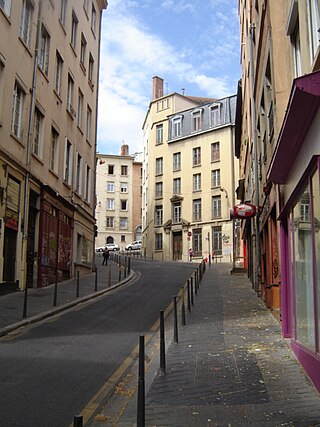
The Montée des Carmélites is one of the oldest streets of Lyon, dating from Roman times, located in the 1st arrondissement of Lyon. It connects the Saint-Vincent quarter to the Plateau de la Croix-Rousse. It is situated between the Rue de la Tourette and the Rue Ray Fernand, and ends at the intersection of the Rue Burdeau, Rue du Jardin des Plantes and Rue de l'Annonciade.

The Rue Lanterne is one of the oldest streets of Lyon, created in the Middle Ages, which is located in the 1st arrondissement of Lyon. It begins after the rue d'Algérie and ends against a facade of the rue Longue.

The Avenue du Maréchal de Saxe is a broad avenue located in the 3rd and the 6th arrondissements of Lyon. It was named after Maurice de Saxe, Marshal of France.

The Rue de Vendôme is a very long street located in Lyon. It begins with the Avenue de Grande Bretagne, along the Rhône, in the 6th arrondissement, and ends with the Cours Gambetta, in the 3rd arrondissement, after crossing the Place Guichard.
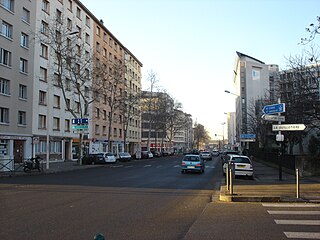
The Rue Garibaldi is a wide and long street in Lyon, located in the 7th, 3rd and 6th arrondissements, and named after Italian politician Giuseppe Garibaldi. There was also a square named Place Garibaldi in reference to his nephews, died during the World War I.
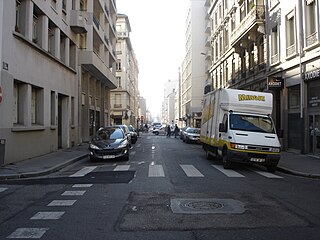
La Rue de Créqui is a very long street located in the 7th, 3rd and 6th arrondissements of Lyon. It is a long straight line along the Rue Duguesclin or the Rue de Vendôme, that begins on the Grande Rue de la Guillotière in the 7th arrondissement and ends at the north in the 6th, on the Boulevard des Belges. It follows the Place Guichard, located in the 3rd arrondissement.

The Rue de l'Arbre-Sec is an old street located in the 1st arrondissement of Lyon, near the Place des Terreaux and the Opera Nouvel. It starts perpendicular to the Rue Édouard-Herriot and ends with the Quai Jean Moulin crossing the Rue de la République. The name dates from the 14th century and was probably chosen because of a dry tree that could be seen in this street and of an inn sign.

The Rue du Bœuf is a 188-metre cobbled pedestrian street of the Vieux Lyon quarter, located in the 5th arrondissement of Lyon. Very representative of the Renaissance architecture of the neighborhood, it is lined only with old houses from the 16th or 17th century. The street connects the Rue de Gadagne which it continues after the Place du Petit Collège and the intersection of the Rue du Chemin Neuf, the Rue de la Bombarde and the Rue Tramassac which prolongs it. The street belongs to the zone classified as World Heritage Site by UNESCO.
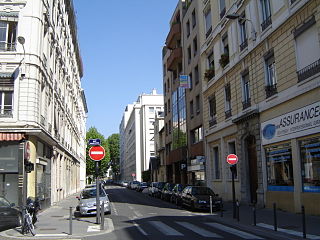
The Rue Tronchet is a street located in the 6th arrondissement of Lyon, named after French jurist François Denis Tronchet (1726–1804).

The Rue de Gadagne is a paved pedestrian street in the Saint-Jean quarter, in the 5th arrondissement of Lyon, France. It extends the Rue du Bœuf and ends on the Rue Lainerie that leads itself to Place Saint-Paul. It is located in the center of Vieux Lyon and is part to the area which includes a mosaic of squares: the Place du Change, Place du Petit Collège and Place de la Baleine in the extension of the Rue Saint-Jean. The street belongs to the zone classified as a World Heritage Site by UNESCO.

The Place Croix-Paquet is a square located in the 1st arrondissement of Lyon, in the pentes de la Croix-Rousse quarter. It is formed by the intersection of the rue du Griffon, the rue des Capucins and the montée Saint-Sébastien. The square belongs to the zone classified World Heritage Site by UNESCO.



















